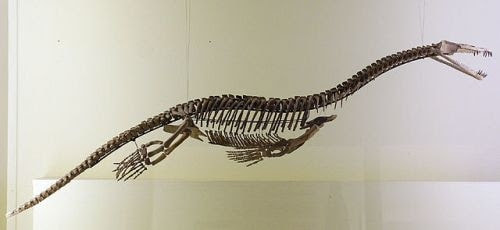|
My books in the Diffusion series are filled with amazing creatures, some which are cute and cuddly, but many which are downright scary. That's what makes it fun, right? In Profusion, Bobby has a terrifying encounter with a creature called a nothosaurus. The nothosaurus (meaning "false lizard") was a reptile that lived from about 240 to 210 million years ago. It was widespread, with fossils being found throughout North America, Europe, and China. As prehistoric aquatic reptiles go, the nothosaurus was not particularly large, averaging less than 13 feet (4 meters) long. Today's crocodiles get considerably larger. But that doesn't mean you would want one to grab onto you while you're taking a swim. They had wide, flat mouths with very sharp teeth. Amazing facts about the Nothosaurus These creatures had strong legs (unlike the flippers of many of the more aquatically-adapted marine reptiles that came later), and they could probably walk on land, perhaps about as well as today's seals and sea lions. This is why one of these was able to come out of the water and pursue Bobby (in Profusion). Many of them even had clawed feet rather than flippers. See the image below. Nothosaurs had very long, sharp teeth adapted for catching fish (and perhaps any other smaller aquatic creatures, such as squid). We have an idea of how they hunted because scientists have found fossils of trackways left behind as they dug into the soft seabed with their paddle-like forelimbs, probably trying to churn up hiding creatures, which they would snap up in their teeth. See trackway in the image below. There were at least twelve species of nothosaurus (probably more, as a very small percentage of prehistoric animals became fossilized). The first nothosaurus fossil to be found and identified was in Germany in 1833. See the photo below from the Berlin Museum of Natural History. Want to get a feel for the size and shape of the nothosaurus? Take a look at this video of a walk-around of a life-size replica in a museum in Karlsruhe, Germany. Based upon their body structure, nothosaurs probably spent most of their time on land near the water (like today's seals), sliding into the water mainly to feed. I wonder if they also were as playful in the water as today's seals are...? I also wonder what kind of vocalizations they made. Did they bark like seals? We still don't know if nothosaurus laid eggs or gave birth to live young. But it's likely they had live birth, because many of the ichthyosaurs (and the later plesiosaurs) had live birth, and they are thought to have evolved from the nothosaurs. But we still don't have an accurate estimate of when live birth in marine reptiles began. So, the Nothosaurus deserves a place in the B.A.H.O.F. (Bad Animal Hall of Fame). FUN FACT: Bad is an example of a word that has evolved to mean the opposite of its original meaning. It was popularized in 1987 by Michael Jackson with his hit song, Bad. But most people don't know that "bad" was used to mean "good" long before that. The earliest reference in the Oxford English Dictionary was from the 1897 Pink Marsh, by George Ade: “She sutny fix up a pohk chop ‘at’s bad to eat.” So, in other words, bad is another way to say awesome. Photo Credits:
Nothosaurus group by shore - Dinoraul on Renderosity Detailed Nothosaur, showing feet - DK Findout! Nothosaurus leaving trackway - Nature.com-Original artwork Brian Choo Nothosaurus Fossil Skeleton - Berlin Museum of Natural History, photo by Elke Wetzig
1 Comment
|
Stan's Cogitations
Everyone needs a creative outlet. That's why I write. Archives
July 2024
|





 RSS Feed
RSS Feed